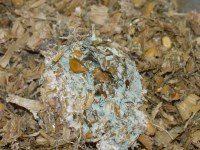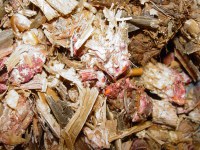Check Corn Silage for Spoilage
(Click an image below to view a high-resolution image that can be downloaded)
A belated corn silage harvest in 2009 set the stage for spoilage problems this spring if the corn was not ensiled properly last fall, North Dakota State University Extension Service dairy specialist J.W. Schroeder warns.
“Cold winter temperatures delayed potential storage problems, but as the ambient temperature rises into the 50s and above, that cold-stored silage also will start to warm up,” he says. “In situations where proper ensiling techniques were compromised, now is the time to recheck those silage piles.”
Early reports of feed tested for mycotoxins (toxins produced by certain types of mold) this spring appear to be consistent with test results from last fall. The crops harvested and tested from the Dakotas and Minnesota recently don’t appear to be any worse off than those tested last fall.
“That is no guarantee, however, so producers and nutritionists may want to test their silage piles as spring weather arrives,” Schroeder says. “Many techniques are available to evaluate silages, including sight and smell, so if the stored feed doesn’t appear normal, look further.”
Dairy producers have begun noting some rather colorful silages this spring. An orange hue likely is the result of bacterial growth. If the silage is red, then Fusarium (a type of fungus) could be growing with the bacteria. Blue and green molds probably are related to the most problematic species of storage mold - Fusarium and Aspergillus.
Fusarium and Aspergillus, along with Penicillium and Mucor, are common molds that cause problems.
Silage color can indicate other fermentation problems as well. Silages with excessive acetic acid will have a yellowish hue, while those with a high butyrate content will be a slimy green. Brown to black silage usually indicates heating from fermentation and moisture damage. These silages have the highest potential for molding and are unacceptable as feed. White usually is indicative of secondary mold growth.
Silage odors also can be used to evaluate fermentation. Normal silage has minimal odor due to lactic acid. If acetic acid production is high, then silage may have a vinegar smell. High ethanol content from yeast fermentation may impart an alcohol odor. Clostridial fermentation results in a rancid-butter smell. Propionic acid fermentation results in a sharp, sweet smell and taste. Heat-damaged silages will have a caramelized or tobacco smell.
“No silage should have a musty, mildew or rotten smell due to molding,” Schroeder says. “Remember, if the silage smell is really unpleasant to you, most likely it will be refused by the cow or cause reduced intake.”
Molds and fungi will grow under appropriate conditions and require moisture and heat. High humidity (greater than 70 percent) and moisture content of feed in excess of 15 percent are conducive to fungal growth. Under the right conditions, a fungal bloom can occur, which results in tremendous numbers of fungi contamination in feed in less than 24 hours.
However, mold growth does not mean mycotoxins are present. Conversely, mycotoxin problems may be present in the absence of obvious mold growth. Mycotoxins are very sporadic within a feed and often difficult to measure.
Many laboratories can determine total mold counts for any feed. When reading the test results, expect mold counts for high-quality feeds at less than 300,000 colony-forming units per gram (cfu/g). Mold counts exceeding 600,000 cfu/g of feed are of concern. Extreme mold contamination may have mold counts exceeding 1 million cfu/g of feed.
If a single species of mold is identified at these higher levels, this would be considered significant, especially if it is a known mycotoxin-producing organism (for example, Aspergillus, Penicillium or Fusarium). High mold counts with mixed species are less significant, but the presence of mycotoxin-producing species would be of concern.
“So if your herd is experiencing a decline in milk production not typical for this time of the year or you are noticing more than usual challenges with rebreeding, examine the feeds,” Schroeder advises. “But keep in mind, other spoiled feeds or forages also can compound metabolic problems. For instance, higher-than-usual levels of phytoestrogens have been noted in legume forages this spring. So take time to examine all of your wet feeds.”
NDSU Agriculture Communication
| Source: | J.W. Schroeder, (701) 231-7663, j.w.schroeder@ndsu.edu |
|---|---|
| Editor: | Ellen Crawford, (701) 231-5391, ellen.crawford@ndsu.edu |



